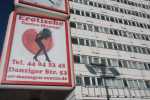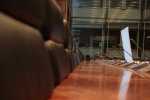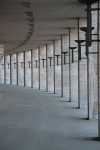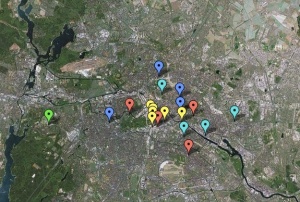I have to say, that I had no idea what to expect when I landed in Berlin from either the city or our agenda, but by the time I left I was completely blown away by both. A huge thank you to all of our Berlin colleagues for a unique, unforgettable, and yes, exhausting week!
As for the city itself, I was struck by its contrasts—the glittering new Hauptbahnhof versus the gritty mix of industry and residential at Ostkreuz, the commercialization of Alexanderplatz in the former East and the DIY punk scene of Kreuzberg in the West, the massive development at Potsdamer Platz and the nearby abandoned moonscapes remaining where the Wall once ran. In a way, the contrasts reminded me of DC, though the disparity here seems to fall most often along socio-economic and racial lines. Desperately poor neighborhoods have views of the Capitol; wealthy areas have half a dozen options for organic produce while an entire ward of the city (with 60,000+ residents, some 93% of whom are black) has a single grocery. However, for myself the most enduring image is simply the lack of existent pre-war buildings of any size—the sheer scale of the destruction is simply unimaginable. That the entire metropolis was essentially built anew is an astounding testament to the will of Berlin and its people. Then to consider that on top of that the city was still split in half less than two decades ago adds a whole new level to the city’s resolve.
Perhaps that is why one of the most fascinating aspects of Berlin was the one contrast that I did not see. Only once during the whole trip did I ever feel like I was in “East Berlin,” during our walking tour of Karl Marx Allee. The wide avenue lined by towers of socialist housing, accompanied by a lack of street life for the most part had a decidedly different feel than the rest of the city. The architects and planners of the time certainly knew what they were doing (I was especially intrigued by the common sense of the wider sidewalk and green space on the north (sunny) side of the street), but here remained a total rejection of the traditional western urban form. In contrast, the other major modernist housing area that we visited, the Hansaviertel, felt much less rigid, less formal, and somehow more western. On Karl Marx Allee I could almost sense the power of The State physically manifested in the design, while in the Hansviertel the towers deferred to the park.
During the rest of my time in Berlin I honestly could not tell whether I was in the Former East or West, I could not perceive when I had crossed the once formidable wall other than noticing a line of brick pavers in the street. This may be the greatest triumph of the reunification of Germany and Berlin, but in a way it may also do a disservice to future generations who will not be able to fuly comprehend the unique history of their city, and the struggles that it has gone through. I have to wonder if there is or will be public demand to memorialize not the wall itself, but the actions and actors involved in its razing. In the US there may be a corollary in the commemoration of the Civil Rights Movement where the struggle of those who stood up to discrimination such as Martin Luther King, Jr. or Rosa Parks that is celebrated, and the history of slavery is often viewed through that lens.
On the subject of whether Berlin is a capital city, I have to answer emphatically yes, but I am still unsure as to what kind of a capital it is. I never got the impression that I was in a seat of government, but I could not imagine it being anywhere else in Germany. The gleaming modern office towers are typical of a financial and commercial capital, but these in many ways felt no different than a dozen or more American cities. The one area that Berlin is without question a capital is art and culture; individual creativity is proudly on display everywhere. The density of art—architecture, graffiti, fashion, music—across the entire city is amazing, and may not exist anywhere else in the world at this time, and I feel lucky to have seen it, if only for a week.
DC on the other hand is, for better or worse, a governmental capital. This of course does not mean that everyone here is involved in the policy-making, lobbying, or contracting, but the city’s very reason for being is to serve as a home for the federal government. There are thriving subcultures and flourishing moderate density neighborhoods, but the perception of the city remains that it is the nation’s capital. That said, hopefully we as (mostly) outsiders to the government can provide you with a different perspective of DC that many visitors fail to recognize.
I look forward to sharing DC with you and in the process learning even more about my city.
I have uploaded pictures to my Flickr page and I hope that you get a chance to take a look.
Justin Kockritz

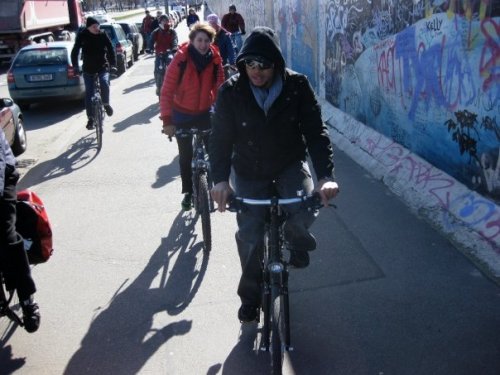 First, I want to express a huge THANK YOU to all of you, our hosts in Berlin. I got so much more out of the insiders’ tour than I would have visiting the city on my own.
First, I want to express a huge THANK YOU to all of you, our hosts in Berlin. I got so much more out of the insiders’ tour than I would have visiting the city on my own.























